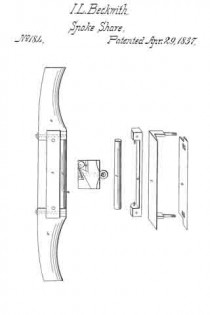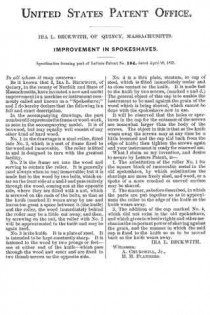
| PLEASE NOTE: The images presented on this page are of low resolution and, as a result, will not print out very well. If you wish to have higher resolution files then you may purchase them for only $2.95 per patent by using the "Buy Now" button below. All purchases are via PayPal. These files have all been cleaned up and digitally enhanced and are therefore suitable for printing, publication or framing. Each zip package contains all the images below (some packages may contain more), and purchased files can be downloaded immediately. |
United States Patent Office.
_________________
IRA L. BECKWITH, OF QUINCY, MASSACHUSETTS.
IMPROVEMENTS IN SPOKESHAVES.
_________________
Specification forming part of Letters Patent No. 184, dated April 29, 1837.
_________________
To all whom it may concern:
Be it known that I, IRA L. BECKWITH, of Quincy, in the county of Norfolk and State of Massachusetts, have invented a new and useful improvement in a machine or instrument commonly called and known as a “Spokeshave;” and I do hereby declare that the following is a full and exact description.
In the accompanying drawings, the part numbered 5 represents the frame or wood-work, as seen in the accompanying model. It is of boxwood, but may equally well consist of any other kind of hard wood.
No. 1 in the drawings is a steel roller, fitted into No. 2, which is a sort of frame fixed to the wood and immovable. The roller is fitted in and is designed to turn with the greastest facility.
No. 2 is the frame set into the wood and serving to control the roller. It is generally (and always when in use) immovable; but it is made fast to the wood by two bolts, which enter on the front side at a and b and pass entirely through the wood, coming out at the opposite side, where they are fitted with a nut, which is screwed on the ends of the bolts, so that as the knife (marked 3) wears away by use and leaves too great a space between it (the knife) and the roller, the wood immediately behind the roller may be a little cut away, and then, by screwing on the nut, the roller with No. 2 will be approximated to the knife and may be used again.
No. 3 is the knife. It is a plate of steel. It is intended to be kept constantly sharp. It is fastened to the wood by two prongs or feet — one at either end of the knife — which pass through the wood and enter and are fixed in two thumb-screws on the opposite side.
No. 4 is a thin plate, stratum, or cap of steel, which is fitted immediately under and in close contact to the knife. It is made fast to the knife by two screws, (marked c and d.) The general object of this cap is to enable the instrument to be used against the grain of the wood which is being shaved, which cannot be done with the spokeshave now in use.
It will be observed that the holes or apertures in the cap for the entrance of the screws are somewhat larger than the body of the screws. The object in this is that as the knife wears away the screws may at any time be a little loosened and the cap slid back from the edge of the knife; then tighten the screws again and your instrument is ready for renewed use.
What I claim as my invention, and desire to secure by Letters Patent, is —
1. The substitution of the roller No. 1 for the square block of immovable metal in the old spokeshave, by which substitution the shavings are more freely shed, and wood, or a spoke of a more crooked or curved surface may be shaved.
2. The manner, as before described, in which the parts are put together so as to approximate the roller to the edge of the knife as the knife wears away.
3. The addition of the cap marked No. 4, which did not exist in the old spokeshave, and which gives tho wheelwrights and other mechanics the important power of shaving against the grain, and the manner in which the said cap is fixed to the knife so as to be moved back as the knife wears away.
IRA L. BECKWITH.
Witnesses:
A.CHURCHILL. Jr.,
H. H. FLANDERS.


